Nursing Assignment: Case Study Analysis
VerifiedAdded on 2023/04/06
|14
|3464
|394
AI Summary
This paper discusses the case scenario of a patient undergoing open cholecystectomy and common bile duct exploration, focusing on communication, safety, and teamwork in perioperative care.
Contribute Materials
Your contribution can guide someone’s learning journey. Share your
documents today.
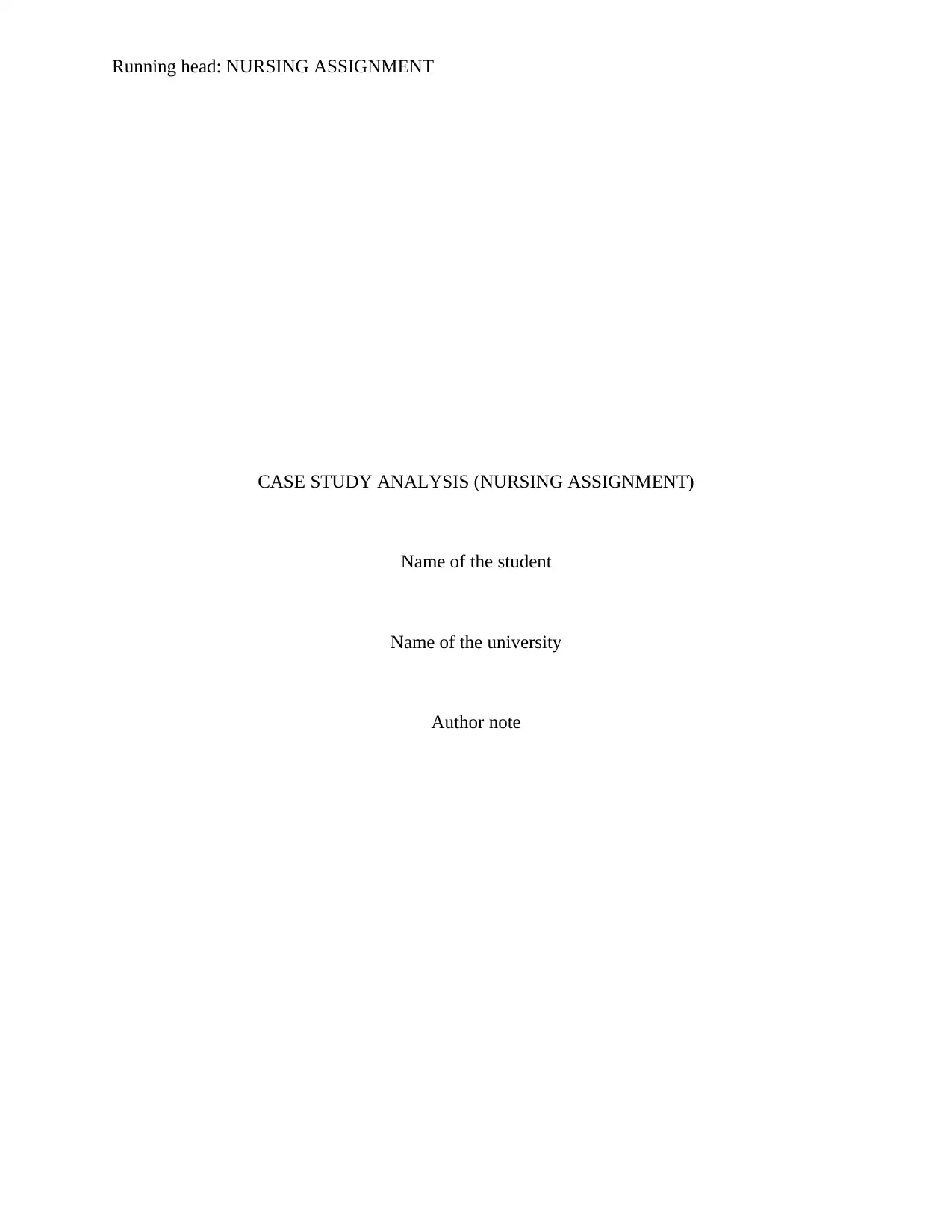
Running head: NURSING ASSIGNMENT
CASE STUDY ANALYSIS (NURSING ASSIGNMENT)
Name of the student
Name of the university
Author note
CASE STUDY ANALYSIS (NURSING ASSIGNMENT)
Name of the student
Name of the university
Author note
Secure Best Marks with AI Grader
Need help grading? Try our AI Grader for instant feedback on your assignments.
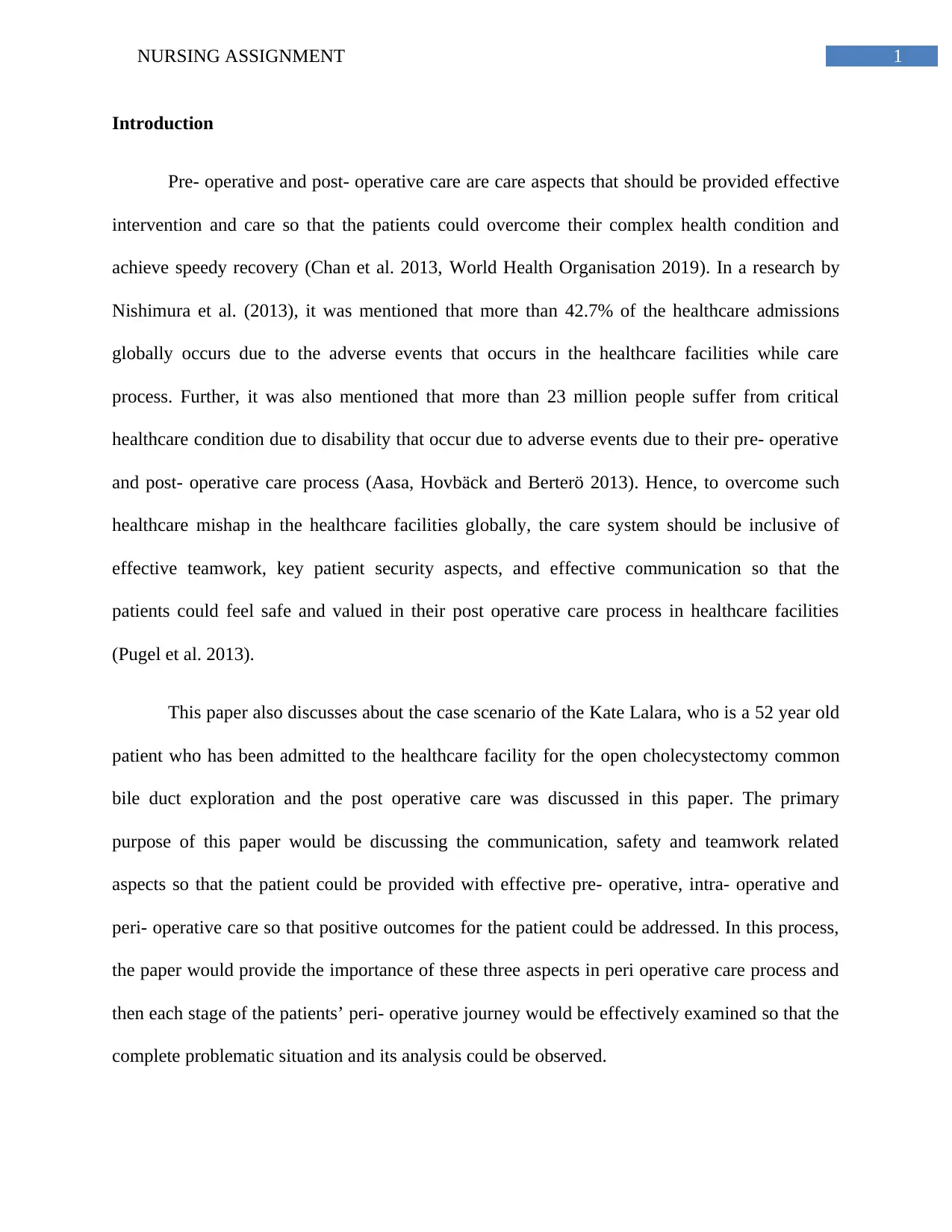
1NURSING ASSIGNMENT
Introduction
Pre- operative and post- operative care are care aspects that should be provided effective
intervention and care so that the patients could overcome their complex health condition and
achieve speedy recovery (Chan et al. 2013, World Health Organisation 2019). In a research by
Nishimura et al. (2013), it was mentioned that more than 42.7% of the healthcare admissions
globally occurs due to the adverse events that occurs in the healthcare facilities while care
process. Further, it was also mentioned that more than 23 million people suffer from critical
healthcare condition due to disability that occur due to adverse events due to their pre- operative
and post- operative care process (Aasa, Hovbäck and Berterö 2013). Hence, to overcome such
healthcare mishap in the healthcare facilities globally, the care system should be inclusive of
effective teamwork, key patient security aspects, and effective communication so that the
patients could feel safe and valued in their post operative care process in healthcare facilities
(Pugel et al. 2013).
This paper also discusses about the case scenario of the Kate Lalara, who is a 52 year old
patient who has been admitted to the healthcare facility for the open cholecystectomy common
bile duct exploration and the post operative care was discussed in this paper. The primary
purpose of this paper would be discussing the communication, safety and teamwork related
aspects so that the patient could be provided with effective pre- operative, intra- operative and
peri- operative care so that positive outcomes for the patient could be addressed. In this process,
the paper would provide the importance of these three aspects in peri operative care process and
then each stage of the patients’ peri- operative journey would be effectively examined so that the
complete problematic situation and its analysis could be observed.
Introduction
Pre- operative and post- operative care are care aspects that should be provided effective
intervention and care so that the patients could overcome their complex health condition and
achieve speedy recovery (Chan et al. 2013, World Health Organisation 2019). In a research by
Nishimura et al. (2013), it was mentioned that more than 42.7% of the healthcare admissions
globally occurs due to the adverse events that occurs in the healthcare facilities while care
process. Further, it was also mentioned that more than 23 million people suffer from critical
healthcare condition due to disability that occur due to adverse events due to their pre- operative
and post- operative care process (Aasa, Hovbäck and Berterö 2013). Hence, to overcome such
healthcare mishap in the healthcare facilities globally, the care system should be inclusive of
effective teamwork, key patient security aspects, and effective communication so that the
patients could feel safe and valued in their post operative care process in healthcare facilities
(Pugel et al. 2013).
This paper also discusses about the case scenario of the Kate Lalara, who is a 52 year old
patient who has been admitted to the healthcare facility for the open cholecystectomy common
bile duct exploration and the post operative care was discussed in this paper. The primary
purpose of this paper would be discussing the communication, safety and teamwork related
aspects so that the patient could be provided with effective pre- operative, intra- operative and
peri- operative care so that positive outcomes for the patient could be addressed. In this process,
the paper would provide the importance of these three aspects in peri operative care process and
then each stage of the patients’ peri- operative journey would be effectively examined so that the
complete problematic situation and its analysis could be observed.
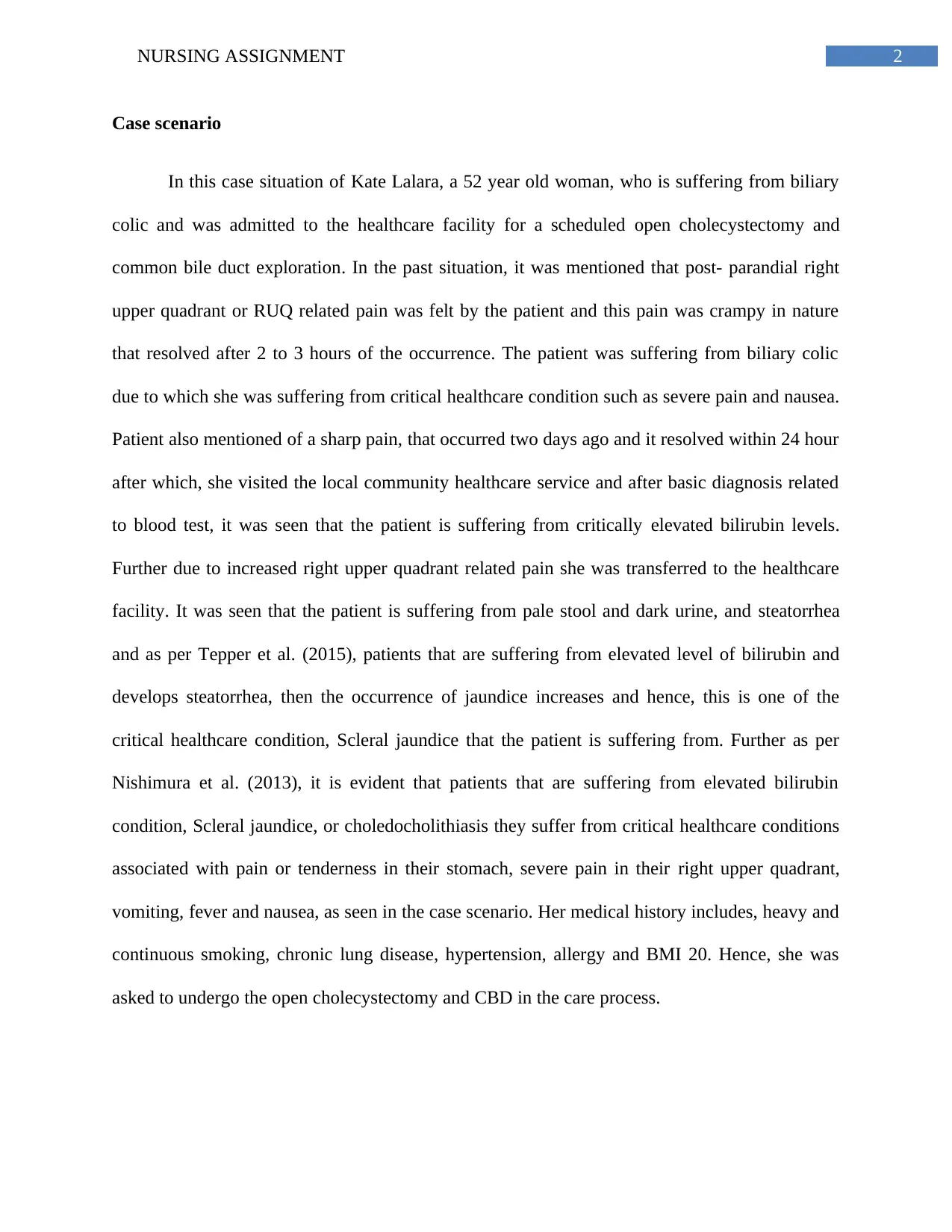
2NURSING ASSIGNMENT
Case scenario
In this case situation of Kate Lalara, a 52 year old woman, who is suffering from biliary
colic and was admitted to the healthcare facility for a scheduled open cholecystectomy and
common bile duct exploration. In the past situation, it was mentioned that post- parandial right
upper quadrant or RUQ related pain was felt by the patient and this pain was crampy in nature
that resolved after 2 to 3 hours of the occurrence. The patient was suffering from biliary colic
due to which she was suffering from critical healthcare condition such as severe pain and nausea.
Patient also mentioned of a sharp pain, that occurred two days ago and it resolved within 24 hour
after which, she visited the local community healthcare service and after basic diagnosis related
to blood test, it was seen that the patient is suffering from critically elevated bilirubin levels.
Further due to increased right upper quadrant related pain she was transferred to the healthcare
facility. It was seen that the patient is suffering from pale stool and dark urine, and steatorrhea
and as per Tepper et al. (2015), patients that are suffering from elevated level of bilirubin and
develops steatorrhea, then the occurrence of jaundice increases and hence, this is one of the
critical healthcare condition, Scleral jaundice that the patient is suffering from. Further as per
Nishimura et al. (2013), it is evident that patients that are suffering from elevated bilirubin
condition, Scleral jaundice, or choledocholithiasis they suffer from critical healthcare conditions
associated with pain or tenderness in their stomach, severe pain in their right upper quadrant,
vomiting, fever and nausea, as seen in the case scenario. Her medical history includes, heavy and
continuous smoking, chronic lung disease, hypertension, allergy and BMI 20. Hence, she was
asked to undergo the open cholecystectomy and CBD in the care process.
Case scenario
In this case situation of Kate Lalara, a 52 year old woman, who is suffering from biliary
colic and was admitted to the healthcare facility for a scheduled open cholecystectomy and
common bile duct exploration. In the past situation, it was mentioned that post- parandial right
upper quadrant or RUQ related pain was felt by the patient and this pain was crampy in nature
that resolved after 2 to 3 hours of the occurrence. The patient was suffering from biliary colic
due to which she was suffering from critical healthcare condition such as severe pain and nausea.
Patient also mentioned of a sharp pain, that occurred two days ago and it resolved within 24 hour
after which, she visited the local community healthcare service and after basic diagnosis related
to blood test, it was seen that the patient is suffering from critically elevated bilirubin levels.
Further due to increased right upper quadrant related pain she was transferred to the healthcare
facility. It was seen that the patient is suffering from pale stool and dark urine, and steatorrhea
and as per Tepper et al. (2015), patients that are suffering from elevated level of bilirubin and
develops steatorrhea, then the occurrence of jaundice increases and hence, this is one of the
critical healthcare condition, Scleral jaundice that the patient is suffering from. Further as per
Nishimura et al. (2013), it is evident that patients that are suffering from elevated bilirubin
condition, Scleral jaundice, or choledocholithiasis they suffer from critical healthcare conditions
associated with pain or tenderness in their stomach, severe pain in their right upper quadrant,
vomiting, fever and nausea, as seen in the case scenario. Her medical history includes, heavy and
continuous smoking, chronic lung disease, hypertension, allergy and BMI 20. Hence, she was
asked to undergo the open cholecystectomy and CBD in the care process.
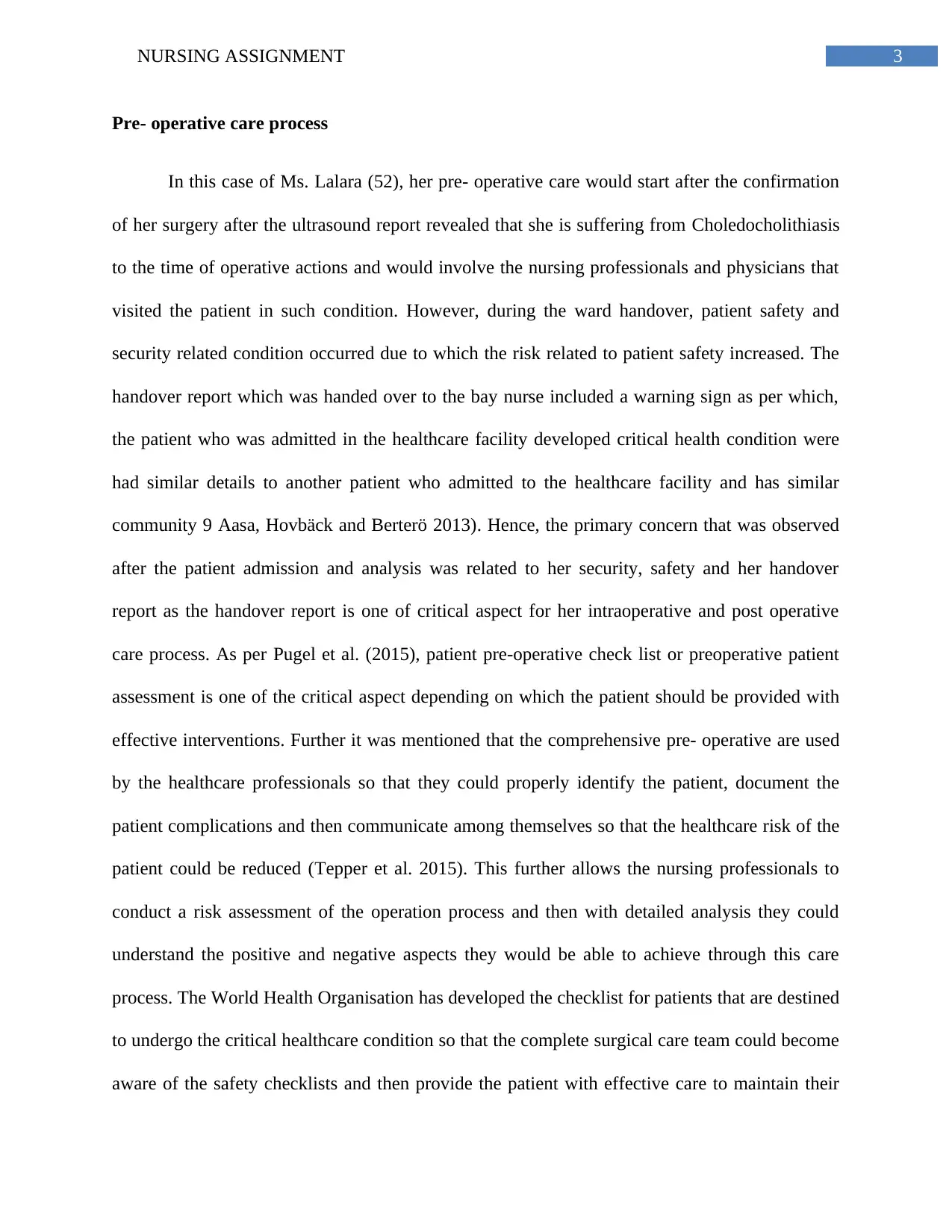
3NURSING ASSIGNMENT
Pre- operative care process
In this case of Ms. Lalara (52), her pre- operative care would start after the confirmation
of her surgery after the ultrasound report revealed that she is suffering from Choledocholithiasis
to the time of operative actions and would involve the nursing professionals and physicians that
visited the patient in such condition. However, during the ward handover, patient safety and
security related condition occurred due to which the risk related to patient safety increased. The
handover report which was handed over to the bay nurse included a warning sign as per which,
the patient who was admitted in the healthcare facility developed critical health condition were
had similar details to another patient who admitted to the healthcare facility and has similar
community 9 Aasa, Hovbäck and Berterö 2013). Hence, the primary concern that was observed
after the patient admission and analysis was related to her security, safety and her handover
report as the handover report is one of critical aspect for her intraoperative and post operative
care process. As per Pugel et al. (2015), patient pre-operative check list or preoperative patient
assessment is one of the critical aspect depending on which the patient should be provided with
effective interventions. Further it was mentioned that the comprehensive pre- operative are used
by the healthcare professionals so that they could properly identify the patient, document the
patient complications and then communicate among themselves so that the healthcare risk of the
patient could be reduced (Tepper et al. 2015). This further allows the nursing professionals to
conduct a risk assessment of the operation process and then with detailed analysis they could
understand the positive and negative aspects they would be able to achieve through this care
process. The World Health Organisation has developed the checklist for patients that are destined
to undergo the critical healthcare condition so that the complete surgical care team could become
aware of the safety checklists and then provide the patient with effective care to maintain their
Pre- operative care process
In this case of Ms. Lalara (52), her pre- operative care would start after the confirmation
of her surgery after the ultrasound report revealed that she is suffering from Choledocholithiasis
to the time of operative actions and would involve the nursing professionals and physicians that
visited the patient in such condition. However, during the ward handover, patient safety and
security related condition occurred due to which the risk related to patient safety increased. The
handover report which was handed over to the bay nurse included a warning sign as per which,
the patient who was admitted in the healthcare facility developed critical health condition were
had similar details to another patient who admitted to the healthcare facility and has similar
community 9 Aasa, Hovbäck and Berterö 2013). Hence, the primary concern that was observed
after the patient admission and analysis was related to her security, safety and her handover
report as the handover report is one of critical aspect for her intraoperative and post operative
care process. As per Pugel et al. (2015), patient pre-operative check list or preoperative patient
assessment is one of the critical aspect depending on which the patient should be provided with
effective interventions. Further it was mentioned that the comprehensive pre- operative are used
by the healthcare professionals so that they could properly identify the patient, document the
patient complications and then communicate among themselves so that the healthcare risk of the
patient could be reduced (Tepper et al. 2015). This further allows the nursing professionals to
conduct a risk assessment of the operation process and then with detailed analysis they could
understand the positive and negative aspects they would be able to achieve through this care
process. The World Health Organisation has developed the checklist for patients that are destined
to undergo the critical healthcare condition so that the complete surgical care team could become
aware of the safety checklists and then provide the patient with effective care to maintain their
Secure Best Marks with AI Grader
Need help grading? Try our AI Grader for instant feedback on your assignments.
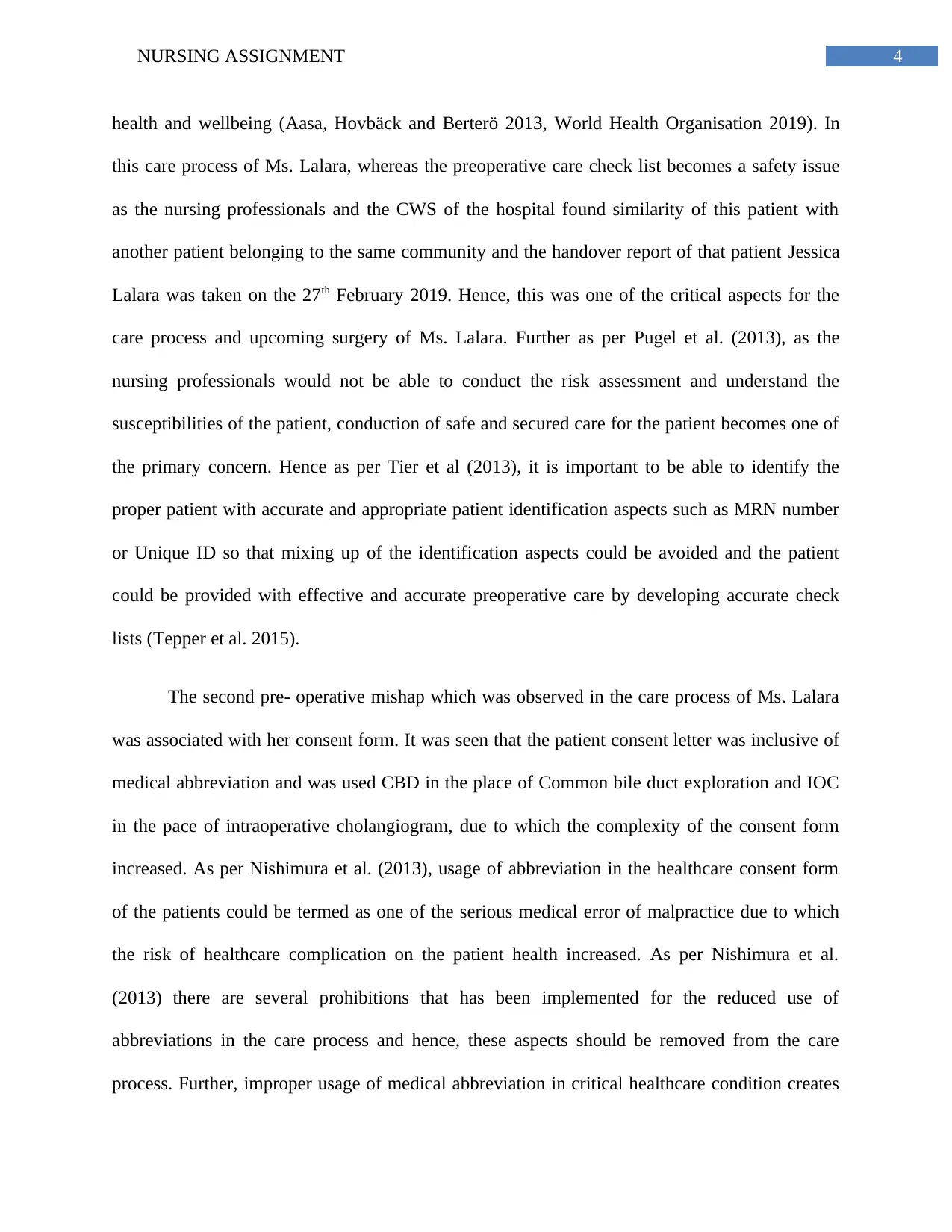
4NURSING ASSIGNMENT
health and wellbeing (Aasa, Hovbäck and Berterö 2013, World Health Organisation 2019). In
this care process of Ms. Lalara, whereas the preoperative care check list becomes a safety issue
as the nursing professionals and the CWS of the hospital found similarity of this patient with
another patient belonging to the same community and the handover report of that patient Jessica
Lalara was taken on the 27th February 2019. Hence, this was one of the critical aspects for the
care process and upcoming surgery of Ms. Lalara. Further as per Pugel et al. (2013), as the
nursing professionals would not be able to conduct the risk assessment and understand the
susceptibilities of the patient, conduction of safe and secured care for the patient becomes one of
the primary concern. Hence as per Tier et al (2013), it is important to be able to identify the
proper patient with accurate and appropriate patient identification aspects such as MRN number
or Unique ID so that mixing up of the identification aspects could be avoided and the patient
could be provided with effective and accurate preoperative care by developing accurate check
lists (Tepper et al. 2015).
The second pre- operative mishap which was observed in the care process of Ms. Lalara
was associated with her consent form. It was seen that the patient consent letter was inclusive of
medical abbreviation and was used CBD in the place of Common bile duct exploration and IOC
in the pace of intraoperative cholangiogram, due to which the complexity of the consent form
increased. As per Nishimura et al. (2013), usage of abbreviation in the healthcare consent form
of the patients could be termed as one of the serious medical error of malpractice due to which
the risk of healthcare complication on the patient health increased. As per Nishimura et al.
(2013) there are several prohibitions that has been implemented for the reduced use of
abbreviations in the care process and hence, these aspects should be removed from the care
process. Further, improper usage of medical abbreviation in critical healthcare condition creates
health and wellbeing (Aasa, Hovbäck and Berterö 2013, World Health Organisation 2019). In
this care process of Ms. Lalara, whereas the preoperative care check list becomes a safety issue
as the nursing professionals and the CWS of the hospital found similarity of this patient with
another patient belonging to the same community and the handover report of that patient Jessica
Lalara was taken on the 27th February 2019. Hence, this was one of the critical aspects for the
care process and upcoming surgery of Ms. Lalara. Further as per Pugel et al. (2013), as the
nursing professionals would not be able to conduct the risk assessment and understand the
susceptibilities of the patient, conduction of safe and secured care for the patient becomes one of
the primary concern. Hence as per Tier et al (2013), it is important to be able to identify the
proper patient with accurate and appropriate patient identification aspects such as MRN number
or Unique ID so that mixing up of the identification aspects could be avoided and the patient
could be provided with effective and accurate preoperative care by developing accurate check
lists (Tepper et al. 2015).
The second pre- operative mishap which was observed in the care process of Ms. Lalara
was associated with her consent form. It was seen that the patient consent letter was inclusive of
medical abbreviation and was used CBD in the place of Common bile duct exploration and IOC
in the pace of intraoperative cholangiogram, due to which the complexity of the consent form
increased. As per Nishimura et al. (2013), usage of abbreviation in the healthcare consent form
of the patients could be termed as one of the serious medical error of malpractice due to which
the risk of healthcare complication on the patient health increased. As per Nishimura et al.
(2013) there are several prohibitions that has been implemented for the reduced use of
abbreviations in the care process and hence, these aspects should be removed from the care
process. Further, improper usage of medical abbreviation in critical healthcare condition creates
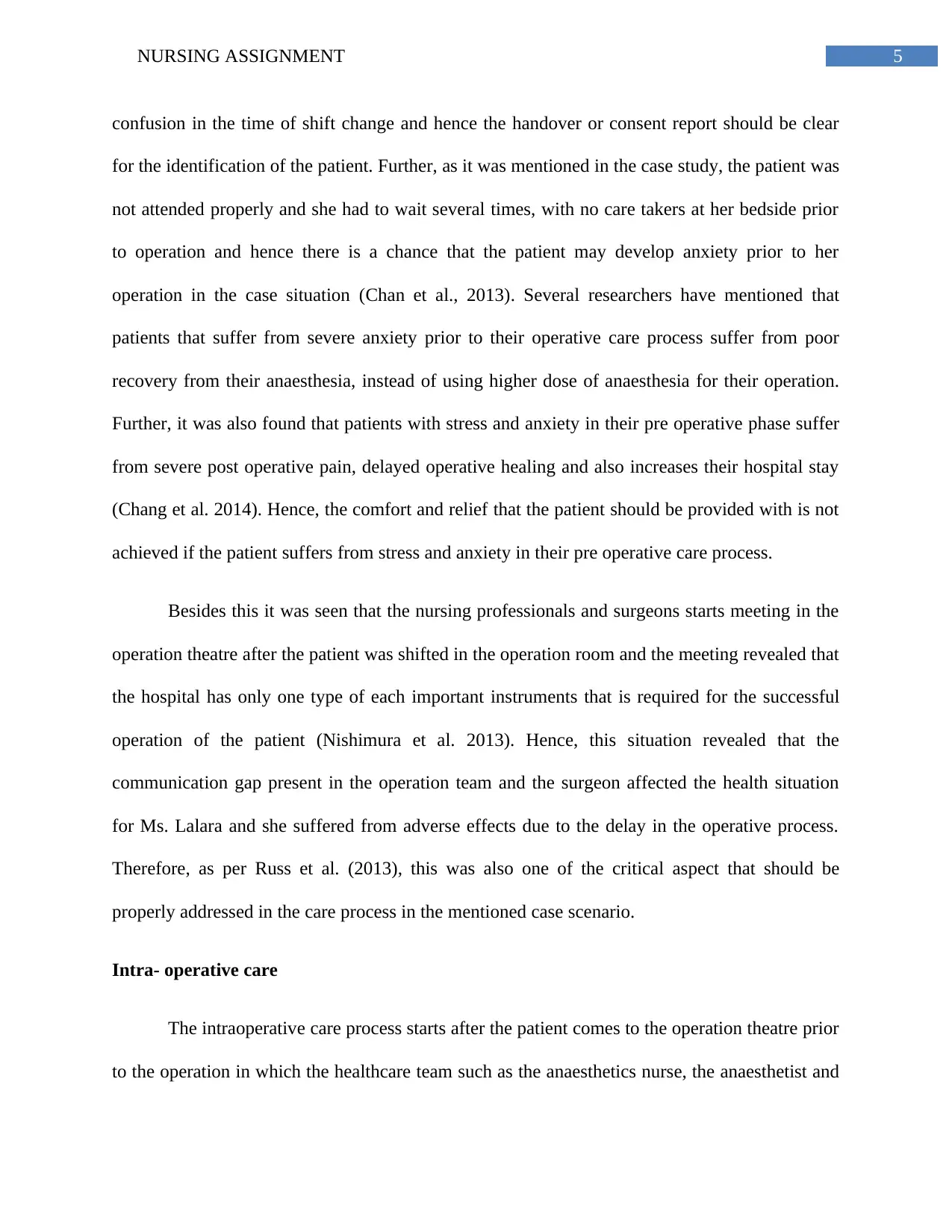
5NURSING ASSIGNMENT
confusion in the time of shift change and hence the handover or consent report should be clear
for the identification of the patient. Further, as it was mentioned in the case study, the patient was
not attended properly and she had to wait several times, with no care takers at her bedside prior
to operation and hence there is a chance that the patient may develop anxiety prior to her
operation in the case situation (Chan et al., 2013). Several researchers have mentioned that
patients that suffer from severe anxiety prior to their operative care process suffer from poor
recovery from their anaesthesia, instead of using higher dose of anaesthesia for their operation.
Further, it was also found that patients with stress and anxiety in their pre operative phase suffer
from severe post operative pain, delayed operative healing and also increases their hospital stay
(Chang et al. 2014). Hence, the comfort and relief that the patient should be provided with is not
achieved if the patient suffers from stress and anxiety in their pre operative care process.
Besides this it was seen that the nursing professionals and surgeons starts meeting in the
operation theatre after the patient was shifted in the operation room and the meeting revealed that
the hospital has only one type of each important instruments that is required for the successful
operation of the patient (Nishimura et al. 2013). Hence, this situation revealed that the
communication gap present in the operation team and the surgeon affected the health situation
for Ms. Lalara and she suffered from adverse effects due to the delay in the operative process.
Therefore, as per Russ et al. (2013), this was also one of the critical aspect that should be
properly addressed in the care process in the mentioned case scenario.
Intra- operative care
The intraoperative care process starts after the patient comes to the operation theatre prior
to the operation in which the healthcare team such as the anaesthetics nurse, the anaesthetist and
confusion in the time of shift change and hence the handover or consent report should be clear
for the identification of the patient. Further, as it was mentioned in the case study, the patient was
not attended properly and she had to wait several times, with no care takers at her bedside prior
to operation and hence there is a chance that the patient may develop anxiety prior to her
operation in the case situation (Chan et al., 2013). Several researchers have mentioned that
patients that suffer from severe anxiety prior to their operative care process suffer from poor
recovery from their anaesthesia, instead of using higher dose of anaesthesia for their operation.
Further, it was also found that patients with stress and anxiety in their pre operative phase suffer
from severe post operative pain, delayed operative healing and also increases their hospital stay
(Chang et al. 2014). Hence, the comfort and relief that the patient should be provided with is not
achieved if the patient suffers from stress and anxiety in their pre operative care process.
Besides this it was seen that the nursing professionals and surgeons starts meeting in the
operation theatre after the patient was shifted in the operation room and the meeting revealed that
the hospital has only one type of each important instruments that is required for the successful
operation of the patient (Nishimura et al. 2013). Hence, this situation revealed that the
communication gap present in the operation team and the surgeon affected the health situation
for Ms. Lalara and she suffered from adverse effects due to the delay in the operative process.
Therefore, as per Russ et al. (2013), this was also one of the critical aspect that should be
properly addressed in the care process in the mentioned case scenario.
Intra- operative care
The intraoperative care process starts after the patient comes to the operation theatre prior
to the operation in which the healthcare team such as the anaesthetics nurse, the anaesthetist and

6NURSING ASSIGNMENT
circulating nurses with scrub nurses were present to help the surgeon for the surgery (Futier et al.
2013). Prior to the conduction of the surgery, patients are provided with antibiotics so that any
allergy or reactions that could occur in the body during the care process could be identified.
After entering the operation theatre the primary role of the scrub nursing professional is to make
sure the entire surgery set up is accurate for the surgery, all the surgical items are sterilised and
all the draping and handling instruments are working properly. As per Kang, Massey and
Gillespie (2015), the scrub nurse is unable to perform their duty and makes mistake in the
arrangement of the instrument and surgical aspects then it could directly affect the patient by
determining adverse event. Further, in adverse conditions, surgeons may also cancel the surgery
as conducting surgery in such minimal resources could affect their health condition. Hence, these
are the aspects that should be assessed prior to provide the patient with anaesthesia or sign in.
After this, it was seen that the patient was given with thoroco-abdominal nerve block
with general anaesthesia so that the patient could be provided with effective pain management
and anaesthesia at the same time (Boretsky 2014). As the nerve block is a type of injection that
helps to decrease the patient’s pain related inflammation, application of GA with this helps to
identify the accurate spot application of injection in which could increase the benefit of the
medicine. Further, as per Chin et al. (2017), it also helps to decrease the rate of nerve damage
due to excessive pain that the patient was suffering from. Hence, this was used for the
application of general anaesthesia in the process. The patient was provided with effective
Standard intraoperative monitoring so that during the operation her body temperature, non
invasive blood pressure, ECG, pulse oximeter, end tidal carbon dioxide could be easily assessed
(Hall Burton and Boretsky 2014). As per Shinoda et al. (2013), application of arterial line while
the care process is one of the most important step using which the surgeon could assess the blood
circulating nurses with scrub nurses were present to help the surgeon for the surgery (Futier et al.
2013). Prior to the conduction of the surgery, patients are provided with antibiotics so that any
allergy or reactions that could occur in the body during the care process could be identified.
After entering the operation theatre the primary role of the scrub nursing professional is to make
sure the entire surgery set up is accurate for the surgery, all the surgical items are sterilised and
all the draping and handling instruments are working properly. As per Kang, Massey and
Gillespie (2015), the scrub nurse is unable to perform their duty and makes mistake in the
arrangement of the instrument and surgical aspects then it could directly affect the patient by
determining adverse event. Further, in adverse conditions, surgeons may also cancel the surgery
as conducting surgery in such minimal resources could affect their health condition. Hence, these
are the aspects that should be assessed prior to provide the patient with anaesthesia or sign in.
After this, it was seen that the patient was given with thoroco-abdominal nerve block
with general anaesthesia so that the patient could be provided with effective pain management
and anaesthesia at the same time (Boretsky 2014). As the nerve block is a type of injection that
helps to decrease the patient’s pain related inflammation, application of GA with this helps to
identify the accurate spot application of injection in which could increase the benefit of the
medicine. Further, as per Chin et al. (2017), it also helps to decrease the rate of nerve damage
due to excessive pain that the patient was suffering from. Hence, this was used for the
application of general anaesthesia in the process. The patient was provided with effective
Standard intraoperative monitoring so that during the operation her body temperature, non
invasive blood pressure, ECG, pulse oximeter, end tidal carbon dioxide could be easily assessed
(Hall Burton and Boretsky 2014). As per Shinoda et al. (2013), application of arterial line while
the care process is one of the most important step using which the surgeon could assess the blood
Paraphrase This Document
Need a fresh take? Get an instant paraphrase of this document with our AI Paraphraser
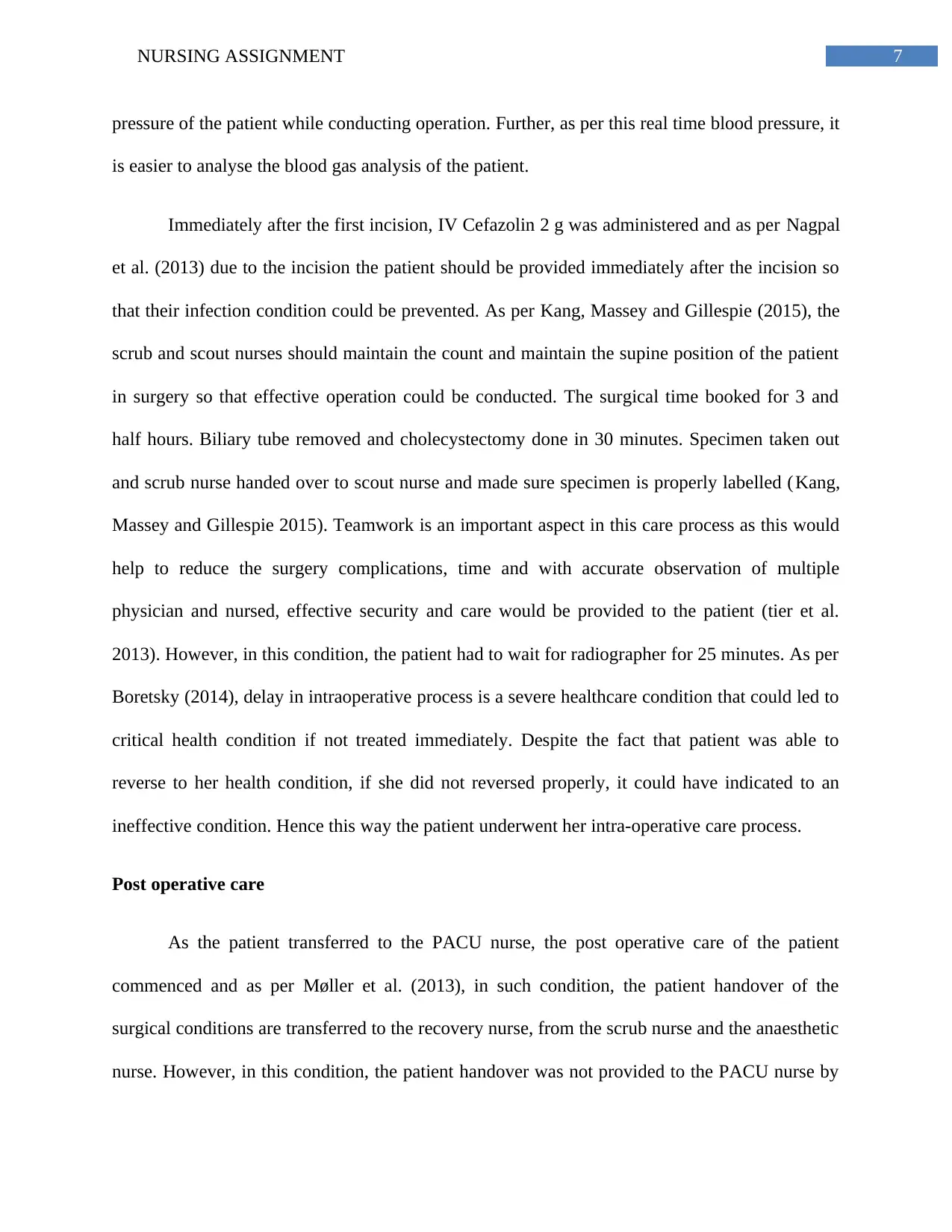
7NURSING ASSIGNMENT
pressure of the patient while conducting operation. Further, as per this real time blood pressure, it
is easier to analyse the blood gas analysis of the patient.
Immediately after the first incision, IV Cefazolin 2 g was administered and as per Nagpal
et al. (2013) due to the incision the patient should be provided immediately after the incision so
that their infection condition could be prevented. As per Kang, Massey and Gillespie (2015), the
scrub and scout nurses should maintain the count and maintain the supine position of the patient
in surgery so that effective operation could be conducted. The surgical time booked for 3 and
half hours. Biliary tube removed and cholecystectomy done in 30 minutes. Specimen taken out
and scrub nurse handed over to scout nurse and made sure specimen is properly labelled (Kang,
Massey and Gillespie 2015). Teamwork is an important aspect in this care process as this would
help to reduce the surgery complications, time and with accurate observation of multiple
physician and nursed, effective security and care would be provided to the patient (tier et al.
2013). However, in this condition, the patient had to wait for radiographer for 25 minutes. As per
Boretsky (2014), delay in intraoperative process is a severe healthcare condition that could led to
critical health condition if not treated immediately. Despite the fact that patient was able to
reverse to her health condition, if she did not reversed properly, it could have indicated to an
ineffective condition. Hence this way the patient underwent her intra-operative care process.
Post operative care
As the patient transferred to the PACU nurse, the post operative care of the patient
commenced and as per Møller et al. (2013), in such condition, the patient handover of the
surgical conditions are transferred to the recovery nurse, from the scrub nurse and the anaesthetic
nurse. However, in this condition, the patient handover was not provided to the PACU nurse by
pressure of the patient while conducting operation. Further, as per this real time blood pressure, it
is easier to analyse the blood gas analysis of the patient.
Immediately after the first incision, IV Cefazolin 2 g was administered and as per Nagpal
et al. (2013) due to the incision the patient should be provided immediately after the incision so
that their infection condition could be prevented. As per Kang, Massey and Gillespie (2015), the
scrub and scout nurses should maintain the count and maintain the supine position of the patient
in surgery so that effective operation could be conducted. The surgical time booked for 3 and
half hours. Biliary tube removed and cholecystectomy done in 30 minutes. Specimen taken out
and scrub nurse handed over to scout nurse and made sure specimen is properly labelled (Kang,
Massey and Gillespie 2015). Teamwork is an important aspect in this care process as this would
help to reduce the surgery complications, time and with accurate observation of multiple
physician and nursed, effective security and care would be provided to the patient (tier et al.
2013). However, in this condition, the patient had to wait for radiographer for 25 minutes. As per
Boretsky (2014), delay in intraoperative process is a severe healthcare condition that could led to
critical health condition if not treated immediately. Despite the fact that patient was able to
reverse to her health condition, if she did not reversed properly, it could have indicated to an
ineffective condition. Hence this way the patient underwent her intra-operative care process.
Post operative care
As the patient transferred to the PACU nurse, the post operative care of the patient
commenced and as per Møller et al. (2013), in such condition, the patient handover of the
surgical conditions are transferred to the recovery nurse, from the scrub nurse and the anaesthetic
nurse. However, in this condition, the patient handover was not provided to the PACU nurse by
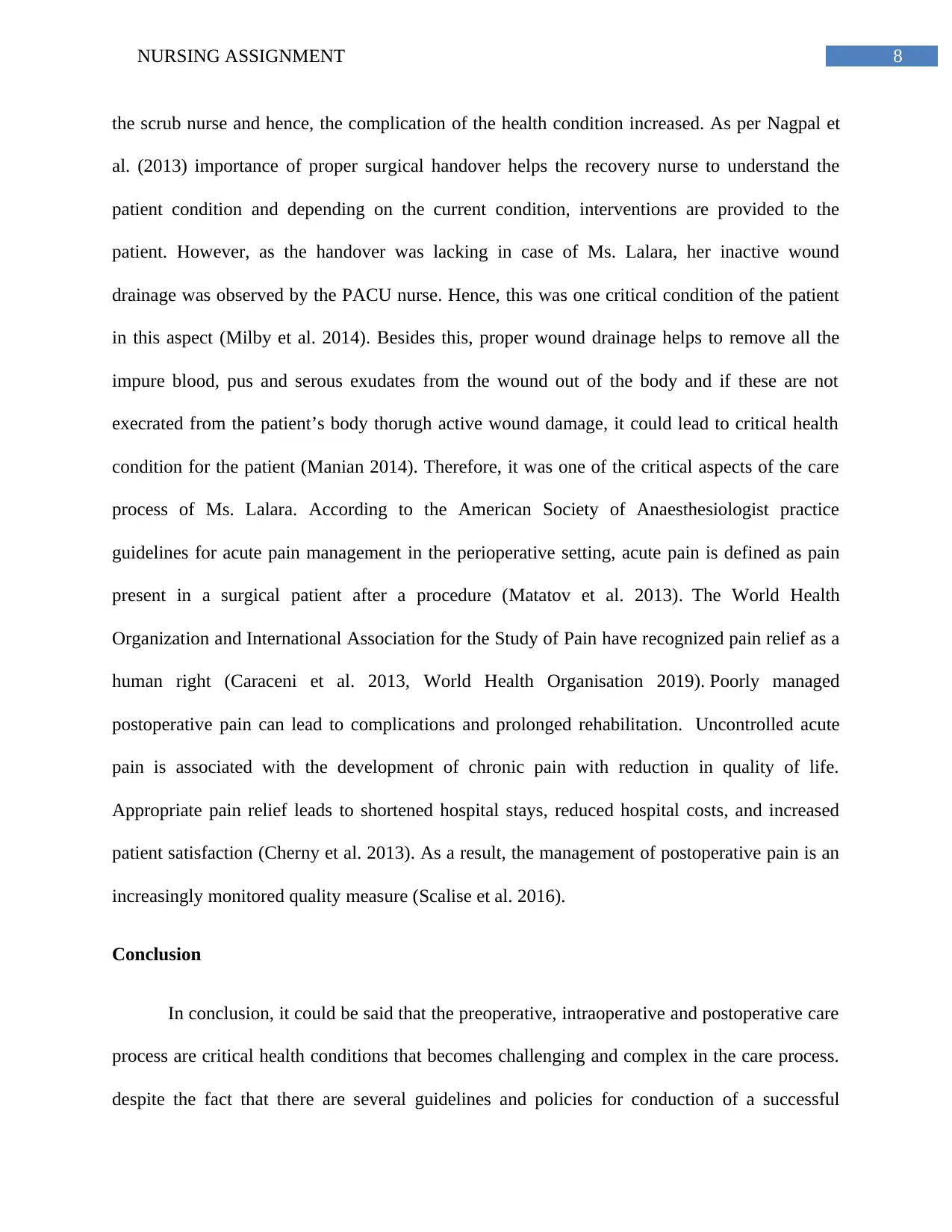
8NURSING ASSIGNMENT
the scrub nurse and hence, the complication of the health condition increased. As per Nagpal et
al. (2013) importance of proper surgical handover helps the recovery nurse to understand the
patient condition and depending on the current condition, interventions are provided to the
patient. However, as the handover was lacking in case of Ms. Lalara, her inactive wound
drainage was observed by the PACU nurse. Hence, this was one critical condition of the patient
in this aspect (Milby et al. 2014). Besides this, proper wound drainage helps to remove all the
impure blood, pus and serous exudates from the wound out of the body and if these are not
execrated from the patient’s body thorugh active wound damage, it could lead to critical health
condition for the patient (Manian 2014). Therefore, it was one of the critical aspects of the care
process of Ms. Lalara. According to the American Society of Anaesthesiologist practice
guidelines for acute pain management in the perioperative setting, acute pain is defined as pain
present in a surgical patient after a procedure (Matatov et al. 2013). The World Health
Organization and International Association for the Study of Pain have recognized pain relief as a
human right (Caraceni et al. 2013, World Health Organisation 2019). Poorly managed
postoperative pain can lead to complications and prolonged rehabilitation. Uncontrolled acute
pain is associated with the development of chronic pain with reduction in quality of life.
Appropriate pain relief leads to shortened hospital stays, reduced hospital costs, and increased
patient satisfaction (Cherny et al. 2013). As a result, the management of postoperative pain is an
increasingly monitored quality measure (Scalise et al. 2016).
Conclusion
In conclusion, it could be said that the preoperative, intraoperative and postoperative care
process are critical health conditions that becomes challenging and complex in the care process.
despite the fact that there are several guidelines and policies for conduction of a successful
the scrub nurse and hence, the complication of the health condition increased. As per Nagpal et
al. (2013) importance of proper surgical handover helps the recovery nurse to understand the
patient condition and depending on the current condition, interventions are provided to the
patient. However, as the handover was lacking in case of Ms. Lalara, her inactive wound
drainage was observed by the PACU nurse. Hence, this was one critical condition of the patient
in this aspect (Milby et al. 2014). Besides this, proper wound drainage helps to remove all the
impure blood, pus and serous exudates from the wound out of the body and if these are not
execrated from the patient’s body thorugh active wound damage, it could lead to critical health
condition for the patient (Manian 2014). Therefore, it was one of the critical aspects of the care
process of Ms. Lalara. According to the American Society of Anaesthesiologist practice
guidelines for acute pain management in the perioperative setting, acute pain is defined as pain
present in a surgical patient after a procedure (Matatov et al. 2013). The World Health
Organization and International Association for the Study of Pain have recognized pain relief as a
human right (Caraceni et al. 2013, World Health Organisation 2019). Poorly managed
postoperative pain can lead to complications and prolonged rehabilitation. Uncontrolled acute
pain is associated with the development of chronic pain with reduction in quality of life.
Appropriate pain relief leads to shortened hospital stays, reduced hospital costs, and increased
patient satisfaction (Cherny et al. 2013). As a result, the management of postoperative pain is an
increasingly monitored quality measure (Scalise et al. 2016).
Conclusion
In conclusion, it could be said that the preoperative, intraoperative and postoperative care
process are critical health conditions that becomes challenging and complex in the care process.
despite the fact that there are several guidelines and policies for conduction of a successful
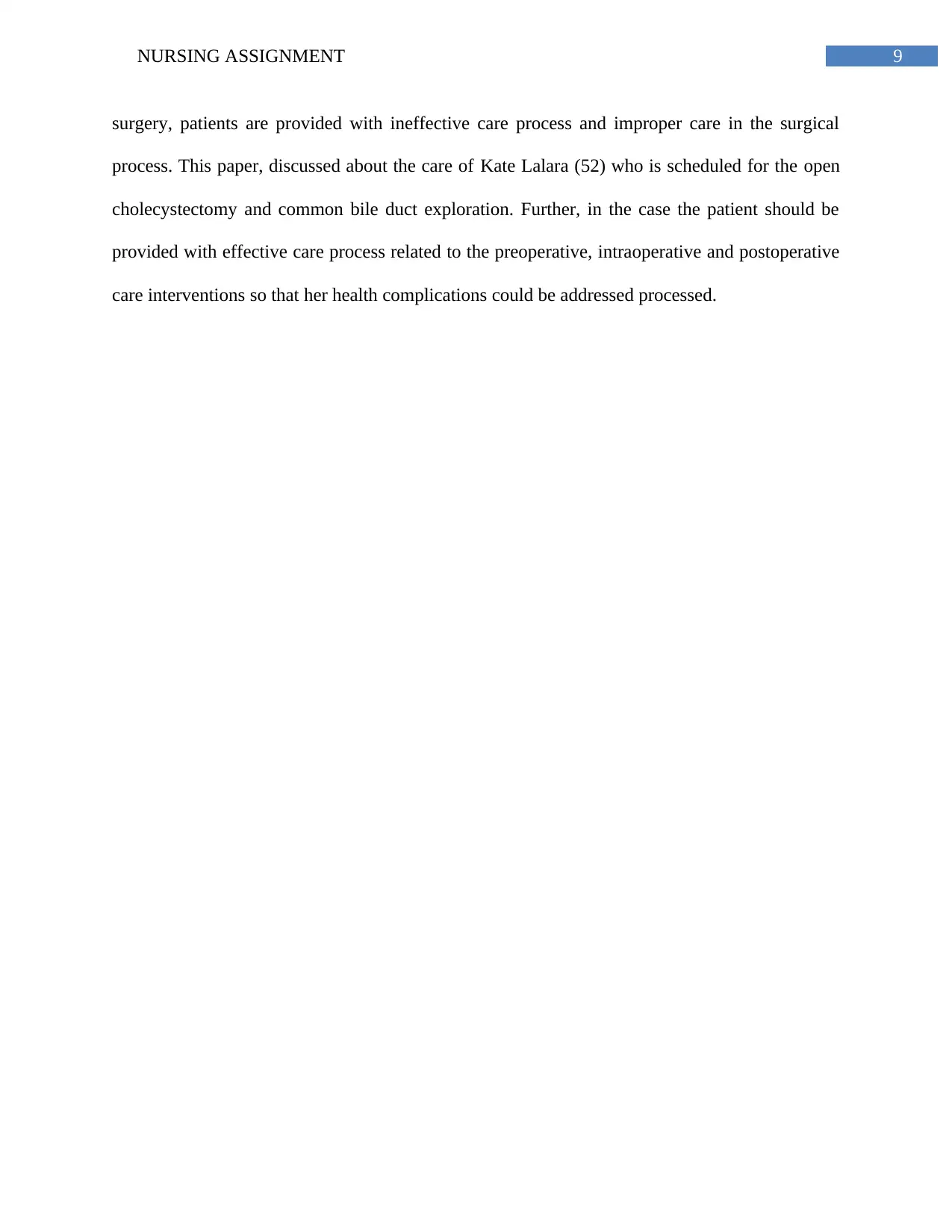
9NURSING ASSIGNMENT
surgery, patients are provided with ineffective care process and improper care in the surgical
process. This paper, discussed about the care of Kate Lalara (52) who is scheduled for the open
cholecystectomy and common bile duct exploration. Further, in the case the patient should be
provided with effective care process related to the preoperative, intraoperative and postoperative
care interventions so that her health complications could be addressed processed.
surgery, patients are provided with ineffective care process and improper care in the surgical
process. This paper, discussed about the care of Kate Lalara (52) who is scheduled for the open
cholecystectomy and common bile duct exploration. Further, in the case the patient should be
provided with effective care process related to the preoperative, intraoperative and postoperative
care interventions so that her health complications could be addressed processed.
Secure Best Marks with AI Grader
Need help grading? Try our AI Grader for instant feedback on your assignments.
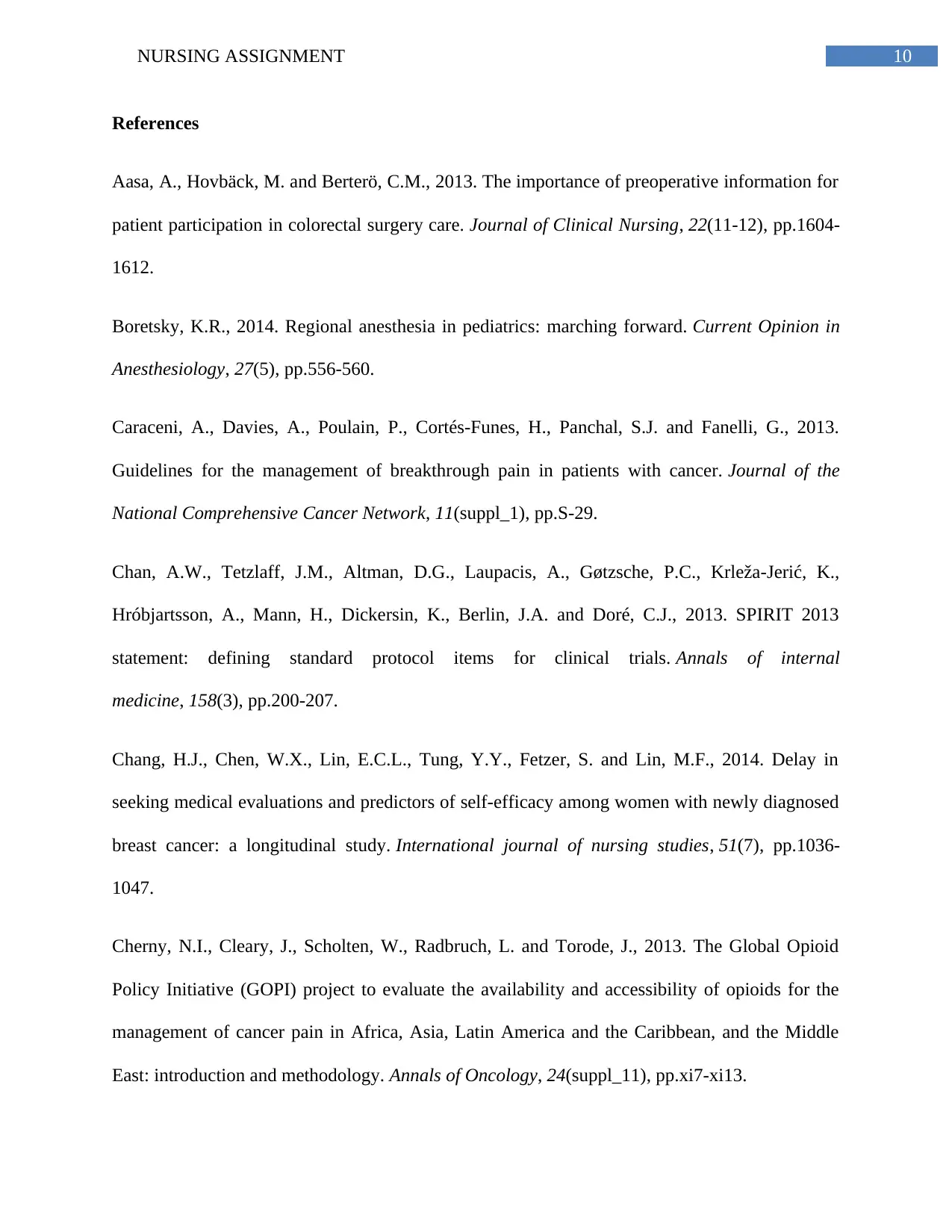
10NURSING ASSIGNMENT
References
Aasa, A., Hovbäck, M. and Berterö, C.M., 2013. The importance of preoperative information for
patient participation in colorectal surgery care. Journal of Clinical Nursing, 22(11-12), pp.1604-
1612.
Boretsky, K.R., 2014. Regional anesthesia in pediatrics: marching forward. Current Opinion in
Anesthesiology, 27(5), pp.556-560.
Caraceni, A., Davies, A., Poulain, P., Cortés-Funes, H., Panchal, S.J. and Fanelli, G., 2013.
Guidelines for the management of breakthrough pain in patients with cancer. Journal of the
National Comprehensive Cancer Network, 11(suppl_1), pp.S-29.
Chan, A.W., Tetzlaff, J.M., Altman, D.G., Laupacis, A., Gøtzsche, P.C., Krleža-Jerić, K.,
Hróbjartsson, A., Mann, H., Dickersin, K., Berlin, J.A. and Doré, C.J., 2013. SPIRIT 2013
statement: defining standard protocol items for clinical trials. Annals of internal
medicine, 158(3), pp.200-207.
Chang, H.J., Chen, W.X., Lin, E.C.L., Tung, Y.Y., Fetzer, S. and Lin, M.F., 2014. Delay in
seeking medical evaluations and predictors of self-efficacy among women with newly diagnosed
breast cancer: a longitudinal study. International journal of nursing studies, 51(7), pp.1036-
1047.
Cherny, N.I., Cleary, J., Scholten, W., Radbruch, L. and Torode, J., 2013. The Global Opioid
Policy Initiative (GOPI) project to evaluate the availability and accessibility of opioids for the
management of cancer pain in Africa, Asia, Latin America and the Caribbean, and the Middle
East: introduction and methodology. Annals of Oncology, 24(suppl_11), pp.xi7-xi13.
References
Aasa, A., Hovbäck, M. and Berterö, C.M., 2013. The importance of preoperative information for
patient participation in colorectal surgery care. Journal of Clinical Nursing, 22(11-12), pp.1604-
1612.
Boretsky, K.R., 2014. Regional anesthesia in pediatrics: marching forward. Current Opinion in
Anesthesiology, 27(5), pp.556-560.
Caraceni, A., Davies, A., Poulain, P., Cortés-Funes, H., Panchal, S.J. and Fanelli, G., 2013.
Guidelines for the management of breakthrough pain in patients with cancer. Journal of the
National Comprehensive Cancer Network, 11(suppl_1), pp.S-29.
Chan, A.W., Tetzlaff, J.M., Altman, D.G., Laupacis, A., Gøtzsche, P.C., Krleža-Jerić, K.,
Hróbjartsson, A., Mann, H., Dickersin, K., Berlin, J.A. and Doré, C.J., 2013. SPIRIT 2013
statement: defining standard protocol items for clinical trials. Annals of internal
medicine, 158(3), pp.200-207.
Chang, H.J., Chen, W.X., Lin, E.C.L., Tung, Y.Y., Fetzer, S. and Lin, M.F., 2014. Delay in
seeking medical evaluations and predictors of self-efficacy among women with newly diagnosed
breast cancer: a longitudinal study. International journal of nursing studies, 51(7), pp.1036-
1047.
Cherny, N.I., Cleary, J., Scholten, W., Radbruch, L. and Torode, J., 2013. The Global Opioid
Policy Initiative (GOPI) project to evaluate the availability and accessibility of opioids for the
management of cancer pain in Africa, Asia, Latin America and the Caribbean, and the Middle
East: introduction and methodology. Annals of Oncology, 24(suppl_11), pp.xi7-xi13.
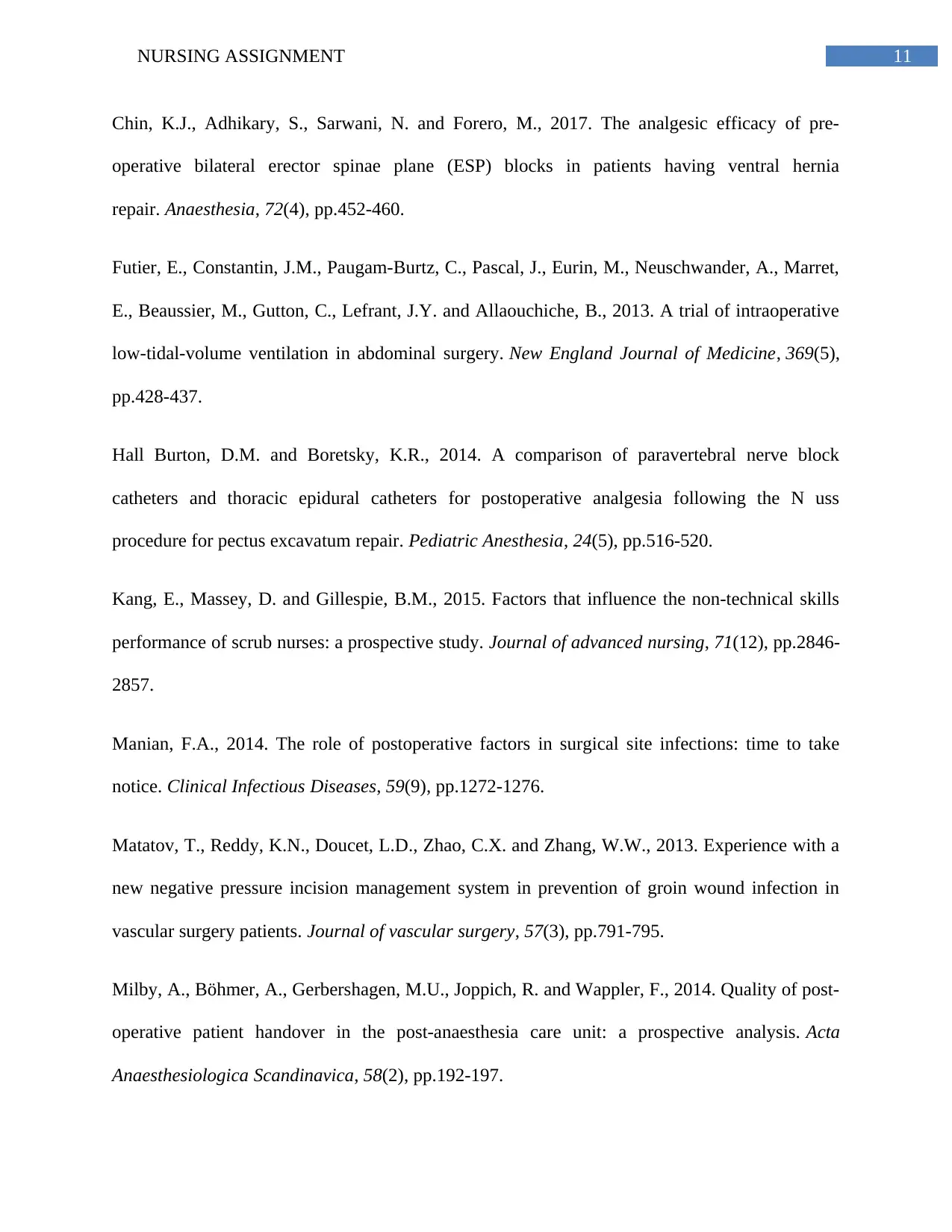
11NURSING ASSIGNMENT
Chin, K.J., Adhikary, S., Sarwani, N. and Forero, M., 2017. The analgesic efficacy of pre‐
operative bilateral erector spinae plane (ESP) blocks in patients having ventral hernia
repair. Anaesthesia, 72(4), pp.452-460.
Futier, E., Constantin, J.M., Paugam-Burtz, C., Pascal, J., Eurin, M., Neuschwander, A., Marret,
E., Beaussier, M., Gutton, C., Lefrant, J.Y. and Allaouchiche, B., 2013. A trial of intraoperative
low-tidal-volume ventilation in abdominal surgery. New England Journal of Medicine, 369(5),
pp.428-437.
Hall Burton, D.M. and Boretsky, K.R., 2014. A comparison of paravertebral nerve block
catheters and thoracic epidural catheters for postoperative analgesia following the N uss
procedure for pectus excavatum repair. Pediatric Anesthesia, 24(5), pp.516-520.
Kang, E., Massey, D. and Gillespie, B.M., 2015. Factors that influence the non‐technical skills
performance of scrub nurses: a prospective study. Journal of advanced nursing, 71(12), pp.2846-
2857.
Manian, F.A., 2014. The role of postoperative factors in surgical site infections: time to take
notice. Clinical Infectious Diseases, 59(9), pp.1272-1276.
Matatov, T., Reddy, K.N., Doucet, L.D., Zhao, C.X. and Zhang, W.W., 2013. Experience with a
new negative pressure incision management system in prevention of groin wound infection in
vascular surgery patients. Journal of vascular surgery, 57(3), pp.791-795.
Milby, A., Böhmer, A., Gerbershagen, M.U., Joppich, R. and Wappler, F., 2014. Quality of post‐
operative patient handover in the post‐anaesthesia care unit: a prospective analysis. Acta
Anaesthesiologica Scandinavica, 58(2), pp.192-197.
Chin, K.J., Adhikary, S., Sarwani, N. and Forero, M., 2017. The analgesic efficacy of pre‐
operative bilateral erector spinae plane (ESP) blocks in patients having ventral hernia
repair. Anaesthesia, 72(4), pp.452-460.
Futier, E., Constantin, J.M., Paugam-Burtz, C., Pascal, J., Eurin, M., Neuschwander, A., Marret,
E., Beaussier, M., Gutton, C., Lefrant, J.Y. and Allaouchiche, B., 2013. A trial of intraoperative
low-tidal-volume ventilation in abdominal surgery. New England Journal of Medicine, 369(5),
pp.428-437.
Hall Burton, D.M. and Boretsky, K.R., 2014. A comparison of paravertebral nerve block
catheters and thoracic epidural catheters for postoperative analgesia following the N uss
procedure for pectus excavatum repair. Pediatric Anesthesia, 24(5), pp.516-520.
Kang, E., Massey, D. and Gillespie, B.M., 2015. Factors that influence the non‐technical skills
performance of scrub nurses: a prospective study. Journal of advanced nursing, 71(12), pp.2846-
2857.
Manian, F.A., 2014. The role of postoperative factors in surgical site infections: time to take
notice. Clinical Infectious Diseases, 59(9), pp.1272-1276.
Matatov, T., Reddy, K.N., Doucet, L.D., Zhao, C.X. and Zhang, W.W., 2013. Experience with a
new negative pressure incision management system in prevention of groin wound infection in
vascular surgery patients. Journal of vascular surgery, 57(3), pp.791-795.
Milby, A., Böhmer, A., Gerbershagen, M.U., Joppich, R. and Wappler, F., 2014. Quality of post‐
operative patient handover in the post‐anaesthesia care unit: a prospective analysis. Acta
Anaesthesiologica Scandinavica, 58(2), pp.192-197.
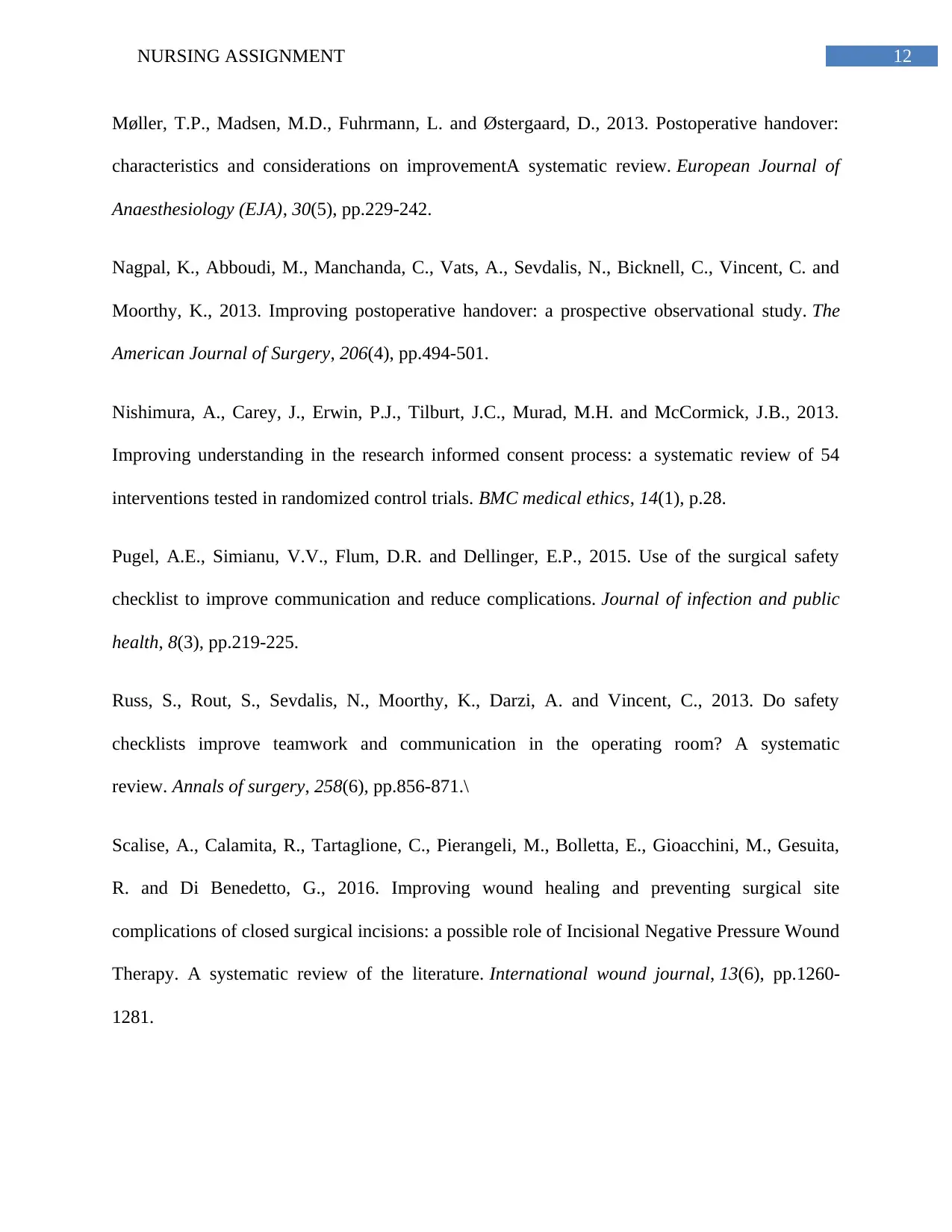
12NURSING ASSIGNMENT
Møller, T.P., Madsen, M.D., Fuhrmann, L. and Østergaard, D., 2013. Postoperative handover:
characteristics and considerations on improvementA systematic review. European Journal of
Anaesthesiology (EJA), 30(5), pp.229-242.
Nagpal, K., Abboudi, M., Manchanda, C., Vats, A., Sevdalis, N., Bicknell, C., Vincent, C. and
Moorthy, K., 2013. Improving postoperative handover: a prospective observational study. The
American Journal of Surgery, 206(4), pp.494-501.
Nishimura, A., Carey, J., Erwin, P.J., Tilburt, J.C., Murad, M.H. and McCormick, J.B., 2013.
Improving understanding in the research informed consent process: a systematic review of 54
interventions tested in randomized control trials. BMC medical ethics, 14(1), p.28.
Pugel, A.E., Simianu, V.V., Flum, D.R. and Dellinger, E.P., 2015. Use of the surgical safety
checklist to improve communication and reduce complications. Journal of infection and public
health, 8(3), pp.219-225.
Russ, S., Rout, S., Sevdalis, N., Moorthy, K., Darzi, A. and Vincent, C., 2013. Do safety
checklists improve teamwork and communication in the operating room? A systematic
review. Annals of surgery, 258(6), pp.856-871.\
Scalise, A., Calamita, R., Tartaglione, C., Pierangeli, M., Bolletta, E., Gioacchini, M., Gesuita,
R. and Di Benedetto, G., 2016. Improving wound healing and preventing surgical site
complications of closed surgical incisions: a possible role of Incisional Negative Pressure Wound
Therapy. A systematic review of the literature. International wound journal, 13(6), pp.1260-
1281.
Møller, T.P., Madsen, M.D., Fuhrmann, L. and Østergaard, D., 2013. Postoperative handover:
characteristics and considerations on improvementA systematic review. European Journal of
Anaesthesiology (EJA), 30(5), pp.229-242.
Nagpal, K., Abboudi, M., Manchanda, C., Vats, A., Sevdalis, N., Bicknell, C., Vincent, C. and
Moorthy, K., 2013. Improving postoperative handover: a prospective observational study. The
American Journal of Surgery, 206(4), pp.494-501.
Nishimura, A., Carey, J., Erwin, P.J., Tilburt, J.C., Murad, M.H. and McCormick, J.B., 2013.
Improving understanding in the research informed consent process: a systematic review of 54
interventions tested in randomized control trials. BMC medical ethics, 14(1), p.28.
Pugel, A.E., Simianu, V.V., Flum, D.R. and Dellinger, E.P., 2015. Use of the surgical safety
checklist to improve communication and reduce complications. Journal of infection and public
health, 8(3), pp.219-225.
Russ, S., Rout, S., Sevdalis, N., Moorthy, K., Darzi, A. and Vincent, C., 2013. Do safety
checklists improve teamwork and communication in the operating room? A systematic
review. Annals of surgery, 258(6), pp.856-871.\
Scalise, A., Calamita, R., Tartaglione, C., Pierangeli, M., Bolletta, E., Gioacchini, M., Gesuita,
R. and Di Benedetto, G., 2016. Improving wound healing and preventing surgical site
complications of closed surgical incisions: a possible role of Incisional Negative Pressure Wound
Therapy. A systematic review of the literature. International wound journal, 13(6), pp.1260-
1281.
Paraphrase This Document
Need a fresh take? Get an instant paraphrase of this document with our AI Paraphraser
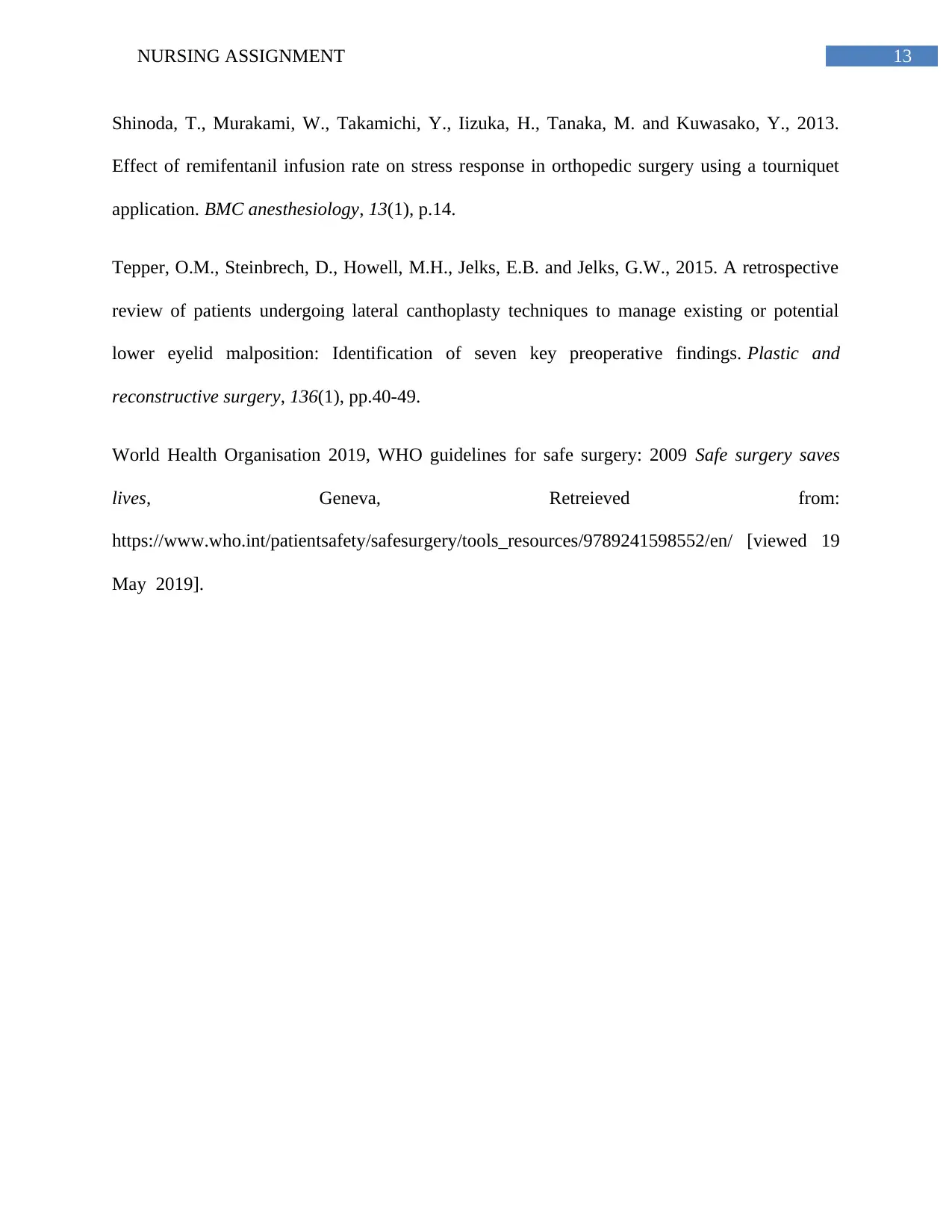
13NURSING ASSIGNMENT
Shinoda, T., Murakami, W., Takamichi, Y., Iizuka, H., Tanaka, M. and Kuwasako, Y., 2013.
Effect of remifentanil infusion rate on stress response in orthopedic surgery using a tourniquet
application. BMC anesthesiology, 13(1), p.14.
Tepper, O.M., Steinbrech, D., Howell, M.H., Jelks, E.B. and Jelks, G.W., 2015. A retrospective
review of patients undergoing lateral canthoplasty techniques to manage existing or potential
lower eyelid malposition: Identification of seven key preoperative findings. Plastic and
reconstructive surgery, 136(1), pp.40-49.
World Health Organisation 2019, WHO guidelines for safe surgery: 2009 Safe surgery saves
lives, Geneva, Retreieved from:
https://www.who.int/patientsafety/safesurgery/tools_resources/9789241598552/en/ [viewed 19
May 2019].
Shinoda, T., Murakami, W., Takamichi, Y., Iizuka, H., Tanaka, M. and Kuwasako, Y., 2013.
Effect of remifentanil infusion rate on stress response in orthopedic surgery using a tourniquet
application. BMC anesthesiology, 13(1), p.14.
Tepper, O.M., Steinbrech, D., Howell, M.H., Jelks, E.B. and Jelks, G.W., 2015. A retrospective
review of patients undergoing lateral canthoplasty techniques to manage existing or potential
lower eyelid malposition: Identification of seven key preoperative findings. Plastic and
reconstructive surgery, 136(1), pp.40-49.
World Health Organisation 2019, WHO guidelines for safe surgery: 2009 Safe surgery saves
lives, Geneva, Retreieved from:
https://www.who.int/patientsafety/safesurgery/tools_resources/9789241598552/en/ [viewed 19
May 2019].
1 out of 14
Related Documents
Your All-in-One AI-Powered Toolkit for Academic Success.
+13062052269
info@desklib.com
Available 24*7 on WhatsApp / Email
![[object Object]](/_next/static/media/star-bottom.7253800d.svg)
Unlock your academic potential
© 2024 | Zucol Services PVT LTD | All rights reserved.





